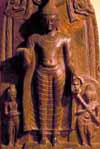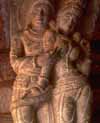|
|
 |
==The
Parsis appear (c.800-900): As Iran becomes Muslim, many followers
of the ancient Persian Zoroastrian faith (*sacred
texts*) come to feel unwelcome in their homeland, and migrate to India.
These "Parsis," named for the region of Fars in Iran, settle on the west
coast, especially in Gujarat, and build what is still a thriving community
in Bombay. The woman in the picture stands before the wall of a Bombay
fire-temple that shows reproductions of the court of Darius the Great in
Persepolis. Images: *Sue
Darlow*. The *Imperial
Gazetteer* gives its own account of the Parsis' history. And there's
the *Qissa-e
Sanjan* too. |
 |
==The
Palas patronize Buddhism (c.750-1150): Ruling in the northeast,
the Pala dynasty becomes prosperous and sophisticated. Its kings patronize
Buddhism, including the universities at Nalanda and Vikramashila. With
the Palas' later decline, Buddhism begins to die out in India; it is also
threatened by the rise of the bhakti movement and occasional raids on monasteries
by early Muslim rulers. Pala Hindu and Buddhist sculpture: *IGNCA*. |
 |
==The
Rajputs make their presence felt (c.800 onwards): Kingdoms
controlled by Rajput rise in Central India and Rajasthan. Rajputs claim
descent from kshatriya, or warrior-caste, lineages, and also from the Sun
or Moon; many scholars think they were originally of Central Asian stock.
They cherish their martial ethic, and fight with each other if nobody else
is available. The *Imperial
Gazetteer* has a good deal of information about their clans and traditions. |
 |
==The
Muslim world expands: By 900, two and a half centuries after
the Muslim world begins to expand from its Arabian heartland, it has come
to include territory all along North Africa and into Spain in the west,
and right up to the Indus River in the east. And of course the sea trade
along the Malabar and Coromandel coasts is as active as ever. |
 |
==Bilhana
(c.800–900): The later Chalukyas patronize the Kashmiri (*kousa*)
poet Bilhana, author of several well-known Sanskrit works including the
"Chaurapanchashika" (Fifty Stanzas of a Thief), which describe a lowborn
lover's clandestine trysts with a princess, and his exulting in the memory
even on the eve of his execution for the crime. Here is an early (c.1920)
and free translation of the text by *Edward
Powys Mathers*. |
|
|






